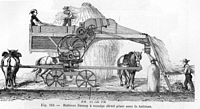Swing riots

Imagine you are at a playground and you see a group of angry people who are upset about something. They are swinging their arms wildly and hitting things around them. This is what the Swing Riots were like, but instead of a playground, it happened in England in the year 1830.
At this time, many people who worked on farms were struggling to make ends meet because the cost of food was very high and their wages were low. They felt like they were being treated unfairly by their employers, who were making a lot of money while they were barely getting by.
One day, a group of farm workers decided to take action and began to destroy machines on the farms that were taking away their jobs. They would swing their arms and use whatever they could find to break the machines.
This led to a movement of similar protests across England, known as the Swing Riots. The protesters were angry and frustrated, and they wanted to be heard by the people in charge. However, they often resorted to violence and destruction in their attempts to make their voices heard.
Eventually, the government was forced to intervene and many protesters were arrested and punished. Despite this, the Swing Riots helped to bring attention to the struggles of working-class people in England and paved the way for change in the future.
At this time, many people who worked on farms were struggling to make ends meet because the cost of food was very high and their wages were low. They felt like they were being treated unfairly by their employers, who were making a lot of money while they were barely getting by.
One day, a group of farm workers decided to take action and began to destroy machines on the farms that were taking away their jobs. They would swing their arms and use whatever they could find to break the machines.
This led to a movement of similar protests across England, known as the Swing Riots. The protesters were angry and frustrated, and they wanted to be heard by the people in charge. However, they often resorted to violence and destruction in their attempts to make their voices heard.
Eventually, the government was forced to intervene and many protesters were arrested and punished. Despite this, the Swing Riots helped to bring attention to the struggles of working-class people in England and paved the way for change in the future.
Related topics others have asked about:
